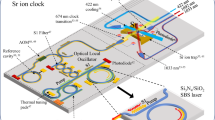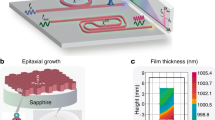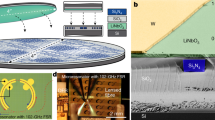Abstract
Spectrally pure lasers, the heart of precision high-end scientific and commercial applications, are poised to make the leap from the laboratory to integrated circuits. Translating this performance to integrated photonics will dramatically reduce cost and footprint for applications such as ultrahigh capacity fibre and data centre networks, atomic clocks and sensing. Despite the numerous applications, integrated lasers currently suffer from large linewidth. Brillouin lasers, with their unique properties, offer an intriguing solution, yet bringing their performance to integrated platforms has remained elusive. Here, we demonstrate a sub-hertz (~0.7 Hz) fundamental linewidth Brillouin laser in an integrated Si3N4 waveguide platform that translates advantages of non-integrated designs to the chip scale. This silicon-foundry-compatible design supports low loss from 405 to 2,350 nm and can be integrated with other components. Single- and multiple-frequency output operation provides a versatile low phase-noise solution. We highlight this by demonstrating an optical gyroscope and a low-phase-noise photonic oscillator.
This is a preview of subscription content, access via your institution
Access options
Access Nature and 54 other Nature Portfolio journals
Get Nature+, our best-value online-access subscription
$29.99 / 30 days
cancel any time
Subscribe to this journal
Receive 12 print issues and online access
$209.00 per year
only $17.42 per issue
Buy this article
- Purchase on Springer Link
- Instant access to full article PDF
Prices may be subject to local taxes which are calculated during checkout






Similar content being viewed by others
Data availability
The data that support the plots within this paper and other finding of this study are available from the corresponding author on reasonable request.
References
Kikuchi, K. Fundamentals of coherent optical fiber communications. J. Lightwave Technol. 34, 157–179 (2016).
Degen, C. L., Reinhard, F. & Cappellaro, P. Quantum sensing. Rev. Mod. Phys. 89, 035002 (2017).
Kitching, J., Knappe, S. & Donley, E. A. Atomic sensors—a review. IEEE. Sens. J. 11, 1749–1758 (2011).
Ludlow, A. D., Boyd, M. M., Ye, J., Peik, E. & Schmidt, P. O. Optical atomic clocks. Rev. Mod. Phys. 87, 637–701 (2015).
Bartels, A., Oates, C. W., Hollberg, L. & Diddams, S. A. Stabilization of femtosecond laser frequency combs with subhertz residual linewidths. Opt. Lett. 29, 1081–1083 (2004).
Young, B. C., Cruz, F. C., Itano, W. M. & Bergquist, J. C. Visible lasers with subhertz linewidths. Phys. Rev. Lett. 82, 3799–3802 (1999).
Ludlow, A. D. et al. Sr lattice clock at 1 × 10−16 fractional uncertainty by remote optical evaluation with a Ca clock. Science 319, 1805–1808 (2008).
Barwood, G. P. et al. Agreement between two 88Sr+ optical clocks to 4 parts in 1017. Phys. Rev. A. 89, 050501(R) (2014).
Carlson, D. R. et al. Self-referenced frequency combs using high-efficiency silicon-nitride waveguides. Opt. Lett. 42, 2314–2317 (2017).
Diddams, S. A., Ye, J. & Hollberg, L. in Femtosecond Optical Frequency Comb Technology: Principle, Operation and Applications (eds Cundiff, S. T. & Ye, J.) 225–262 (Springer, Boston, 2005).
Li, J., Lee, H. & Vahala, K. J. Microwave synthesizer using an on-chip Brillouin oscillator. Nat. Commun. 4, 2097 (2013).
Li, J., Suh, M.-G. & Vahala, K. Microresonator Brillouin gyroscope. Optica 4, 346–348 (2017).
Corbett, J. C. et al. Spanner: Google’s globally-distributed database. In Proc. 10th USENIX Conference on Operating Systems Design and Implementation 251–264 (USENIX Association, 2012).
Hu, H. et al. Single-source chip-based frequency comb enabling extreme parallel data transmission. Nat. Photon. 12, 469–473 (2018).
Perin, J. K., Shastri, A. & Kahn, J. M. Design of low-power DSP-free coherent receivers for data center links. J. Lightwave Technol. 35, 4650–4662 (2017).
Olsson, S. L. et al. Probabilistically shaped PDM 4096-QAM transmission over up to 200 km of fiber using standard intradyne detection. Opt. Express 26, 4522–4530 (2018).
Cisco Visual Networking Index: Forecast and Methodology, 2016–2021 (Cisco, 2017); https://www.cisco.com/c/en/us/solutions/collateral/service-provider/visual-networking-index-vni/complete-white-paper-c11-481360.html
Andrae A. Total Consumer Power Consumption Forecast (researchgate.net, 2017); https://www.researchgate.net/publication/320225452_Total_Consumer_Power_Consumption_Forecast
Hill, K. O., Kawasaki, B. S. & Johnson, D. C. cw Brillouin laser. Appl. Phys. Lett. 28, 608–609 (1976).
Jihong, G. et al. Highly stable low-noise Brillouin fiber laser with ultranarrow spectral linewidth. IEEE Photon. Technol. Lett. 18, 1813–1815 (2006).
Debut, A., Randoux, S. & Zemmouri, J. Linewidth narrowing in Brillouin lasers: theoretical analysis. Phys. Rev. A. 62, 023803 (2000).
Woodward, R. I., Kelleher, E. J., Popov, S. V. & Taylor, J. R. Stimulated Brillouin scattering of visible light in small-core photonic crystal fibers. Opt. Lett. 39, 2330–2333 (2014).
Smith, S. P., Zarinetchi, F. & Ezekiel, S. Narrow-linewidth stimulated Brillouin fiber laser and applications. Opt. Lett. 16, 393–395 (1991).
Loh, W. et al. A microrod-resonator Brillouin laser with 240 Hz absolute linewidth. New J. Phys. 18, 045001 (2016).
Geng, J. & Jiang, S. Pump-to-Stokes transfer of relative intensity noise in Brillouin fiber ring lasers. Opt. Lett. 32, 11–13 (2007).
Behunin, R. O., Otterstrom, N. T., Rakich, P. T., Gundavarapu, S. & Blumenthal, D. J. Fundamental noise dynamics in cascaded-order Brillouin lasers. Phys. Rev. A. 98, 023832 (2018).
Mooradian, A. Laser linewidth. Phys. Today 38, 42–48 (1985).
Santis, C., Vilenchik, Y., Yariv, A., Satyan, N. & Rakuljic, G. Sub-kHz quantum linewidth semiconductor laser on silicon chip. In CLEO: 2015 Postdeadline Paper Digest JTh5A.7 (OSA, 2015).
Fan, Y. et al. 290 Hz intrinsic linewidth from an integrated optical chip-based widely tunable InP-Si3N4 hybrid laser. In CLEO: 2017 Paper Digest JTh5C.9 (OSA, 2017).
Grudinin, I. S., Matsko, A. B. & Maleki, L. Brillouin lasing with a CaF2 whispering gallery mode resonator. Phys. Rev. Lett. 102, 043902 (2009).
Lee, H. et al. Chemically etched ultrahigh-Q wedge-resonator on a silicon chip. Nat. Photon. 6, 369–373 (2012).
Otterstrom, N. T., Behunin, R. O., Kittlaus, E. A., Wang, Z. & Rakich, P. T. A silicon Brillouin laser. Science 360, 1113–1116 (2018).
Morrison, B. et al. Compact Brillouin devices through hybrid integration on silicon. Optica 4, 847–847 (2017).
Kabakova, I. V. et al. Narrow linewidth Brillouin laser based on chalcogenide photonic chip. Opt. Lett. 38, 3208–3211 (2013).
Bauters, J. F. et al. Planar waveguides with less than 0.1 dB/m propagation loss fabricated with wafer bonding. Opt. Express 19, 24090–24101 (2011).
Loh, W. et al. Dual-microcavity narrow-linewidth Brillouin laser. Optica 2, 225–232 (2015).
Blumenthal, D. J. et al. Silicon nitride in silicon photonics. Proc. IEEE 106, 2209–2231 (2018).
Herr, T. et al. Temporal solitons in optical microresonators. Nat. Photon. 8, 145–152 (2013).
Roeloffzen, C. G. H. et al. Low-loss Si3N4 TriPleX optical waveguides: technology and applications overview. IEEE J. Sel. Top. Quantum Electron. 24, 4400321 (2018).
Spencer D. T. et al. Integrated single and multi-layer Si3N4 platform for ultralow loss propagation and small bending radii. In Optical Fiber Communication Conference (pp. Th1A-2) (OSA, 2014).
Huffman, T. A. et al. Integrated resonators in an ultralow loss Si3N4/SiO2 platform for multifunction applications. IEEE J. Sel. Top. Quantum Electron. 24, 5900209 (2018).
Li, J., Lee, H., Yang, K. Y. & Vahala, K. J. Sideband spectroscopy and dispersion measurement in microcavities. Opt. Express 20, 26337–26344 (2012).
Armani, D. K., Kippenberg, T. J., Spillane, S. M. & Vahala, K. J. Ultra-high-Q toroid microcavity on a chip. Nature 421, 925–928 (2003).
Drever, R. W. P. et al. Laser phase and frequency stabilization using an optical resonator. Appl. Phys. B 31, 97–105 (1983).
Fortier, T. M. et al. Generation of ultrastable microwaves via optical frequency division. Nat. Photon. 5, 425–429 (2011).
Liang, W. et al. High spectral purity Kerr frequency comb radio frequency photonic oscillator. Nat. Commun. 6, 7957 (2015).
Merklein, M. et al. Widely tunable, low phase noise microwave source based on a photonic chip. Opt. Lett. 41, 4633–4636 (2016).
Spencer, D. T. et al. An optical-frequency synthesizer using integrated photonics. Nature 557, 81–85 (2018).
Tran, M. et al. Ultra-low-loss silicon waveguides for heterogeneously integrated silicon/III–V photonics. Appl. Sci. 8, 1139 (2018).
Liao, P. et al. Dependence of a microresonator Kerr frequency comb on the pump linewidth. Opt. Lett. 42, 779–782 (2017).
Acknowledgements
This material is based on work supported by the Defense Advanced Research Projects Agency (DARPA) and Space and Naval Warfare Systems Center Pacific (SSC Pacific) under Contract No. N66001-16-C-4017. The views and conclusions contained in this document are those of the authors and should not be interpreted as representing official policies of DARPA or the US Government. We thank R. Lutwak and J. Adeleman for useful discussions. We also thank B. Stamenic for help in processing samples in the UCSB nanofabrication facility, W. Renninger for help with the measurement techniques for Brillouin gain profiles and J. Sexton, J. Hunter and D. Larson at Honeywell for the cladding deposition, pre-cladding preparation and anneal process and Z. Su for help with the figures.
Author information
Authors and Affiliations
Contributions
S.G., G.M.B., R.B., P.T.R. and D.J.B. prepared the manuscript. S.G., G.M.B., M.P. and J.W. contributed equally to performing the system, lasing and noise measurements. T.H., D.B. and J.N. contributed to the Si3N4 integrated laser fabrication. M.P., S.G., D.B., P.T.R., R.B., J.N., K.D.N., M.S. and D.J.B. contributed to the laser design. R.B., P.T.R., M.P., T.Q., S.G. and K.D.N. contributed to the simulation and modelling. G.M.B., C.P., N.C. and S.G. built the radiofrequency calibrated Mach–Zehnder interferometer and ring-down systems and measured the laser resonator properties. S.G., G.M.B., C.P., M.P. and J.W. performed Brillouin gain measurements. All authors contributed to analysing simulated and experimental results. D.J.B., K.D.N., P.T.R. and M.S. supervised and led the scientific collaboration.
Corresponding author
Ethics declarations
Competing interests
The authors declare no competing interests.
Additional information
Publisher’s note: Springer Nature remains neutral with regard to jurisdictional claims in published maps and institutional affiliations.
Supplementary information
Supplementary Information
Supplementary notes and figures
Rights and permissions
About this article
Cite this article
Gundavarapu, S., Brodnik, G.M., Puckett, M. et al. Sub-hertz fundamental linewidth photonic integrated Brillouin laser. Nature Photon 13, 60–67 (2019). https://doi.org/10.1038/s41566-018-0313-2
Received:
Accepted:
Published:
Issue Date:
DOI: https://doi.org/10.1038/s41566-018-0313-2
This article is cited by
-
Strong interactions between solitons and background light in Brillouin-Kerr microcombs
Nature Communications (2024)
-
Integrated optical frequency division for microwave and mmWave generation
Nature (2024)
-
Turnkey photonic flywheel in a microresonator-filtered laser
Nature Communications (2024)
-
Photonic integrated beam delivery for a rubidium 3D magneto-optical trap
Nature Communications (2023)
-
3D integration enables ultralow-noise isolator-free lasers in silicon photonics
Nature (2023)



